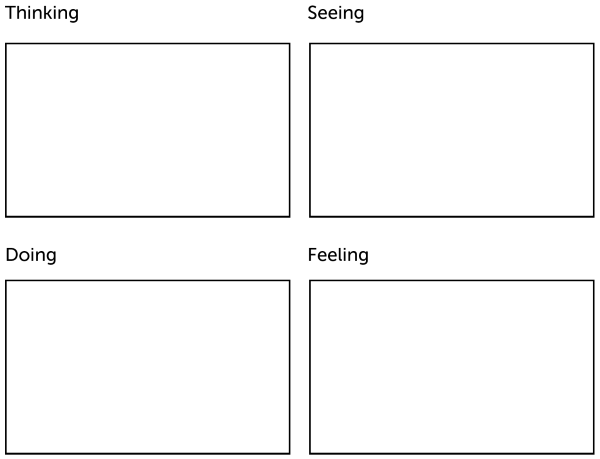Two minutes ago, a customer purchased your product online. Like all your other customers, this is a person, not a demographic.
Strange as it may seem, a demographic has never pulled out a credit card.
So, what do you really know about your customers?
Knowing your prospective customer is the starting point for creating products or services that people want to buy.
It begins at the emotional level by having empathy with them. What are their feelings, thoughts, or attitudes of another? Ideally, it’s putting yourself in their shoes to truly understand them, and this can be achieved by creating an empathy map.
An empathy map represents the sensory information of the customer and is usually shown as four quadrants broken into “Thinking”, “Seeing”, “Doing”, and “Feeling”.
This is not about creating a buyer persona or persona – that comes later. Instead, it’s working out who your ideal audience is to buy from you.
Although they may appear the same, an empathy map is different from a persona.
A buyer persona or avatar is a portrait of a person, one or more, who are your ideal buyers. They exhibit similar behavioral patterns in their purchasing decisions, lifestyle choices, attitudes, and motivations regardless of age, gender, education, and other typical demographics.
Can you see the difference? An empathy map provides emotional information, and a buyer persona shows the behavioral patterns of a prospective customer.
What is empathy?
Empathy is understanding the emotions, feelings, and thoughts of another person from their perspective. It’s putting yourself in their shoes.
Their perspective is very important because it’s their worldview and how they see the world, not yours.
By being able to empathize with your prospective customer you’ll understand them. When you understand them, you can create products and services that they’ll want to buy.
Creating an empathy map
An empathy map creates a composite person and, although fictional, will be the best guestimate based on your research.
Start by drawing the four quadrants of the empathy map and labeling them:
- Thinking
- Seeing
- Doing
- Feeling
You now need to fill in the quadrants to create a realistic and relevant person that will be the customer that you will most likely attract.
Consider the following:
Thinking
- What are their hopes and dreams?
- What are their worries?
- What are they thinking when it comes to the benefits of what your product can offer them?
- What do they hope to gain by using your product?
Seeing
- What is their environment?
- What is their worldview in the context of your product?
- What do they see when they view or use your product?
Doing
- What are their behavior characteristics?
- What are their priorities?
- What influences them and how?
- What are their communication channels?
- What are they doing now they wish was different?
- What outcome would they like by using your product?
Feeling
- What are their fears?
- What holds them back from purchasing?
- Are there other motivational hurdles?
I know this may seem like a lot of work, but it’s research that’s needed to understand your customer. In the long run, it will be invaluable, and you’ll be able to redefine your customer over time.
Different ways to capture information
Here are some ways you can capture the information required to fill out the empathy map.
- Perform online surveys.
- Sitting down and having coffee with people who represent the type of person you want to sell to.
- Social Media observation of groups or communities that represent your ideal audience.
- Be the market – be a member of the group you’ll sell to.
Why empathy maps are important
It’s a long game getting a prospective customer to do business with you, and it begins at the research phase.
For starters, you literally want to be in their shoes. You need to be able to empathize with them, and the best way to do that is with an empathy map.
Creating an empathy map provides the emotional information you’ll need to understand your prospective customer in the context of their worldview.
In the next article, I’ll explore the worldview, which is the why behind behavioral patterns developed with the empathy map.
